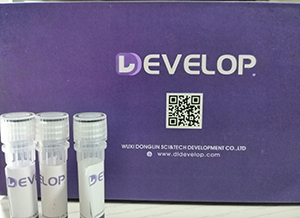Rabbit anti-STAT3 Antibody


| Product name: | Rabbit anti-STAT3 Antibody | |
| Catalog: | DL91114A |
|
| Synonyms : | APRF; Signal transducer and activator of transcription 3; Acute-phase response factor | |
| Reactivity: | H, M, R, B, C, D, Mk, P | |
| Applications: | WB, IHC, IF/IC, IP | |
| Size: | 50uL/100uL | |
| Host: | Rabbit | |
| Clonality: | Polyclonal | |
| Concentration: | 1mg/mL | |
| Immunogen: | KLH-conjugated synthetic peptide encompassing a sequence within the C-term region of human STAT3. The exact sequence is proprietary. | |
| WB description: | Western blot analysis of AP2 alpha/beta expression in HeLa (A), HepG2 (B), mouse brain (C), rat kidney (D) whole cell lysates. | |
| IHC description: | Immunohistochemical analysis of AP2 alpha/beta staining in human lung cancer formalin fixed paraffin embedded tissue section. The section was pre-treated using heat mediated antigen retrieval with sodium citrate buffer (pH 6.0). The section was then incubated with the antibody at room temperature and detected using an HRP conjugated compact polymer system. DAB was used as the chromogen. The section was then counterstained with haematoxylin and mounted with DPX. | |
| IF/ICC description: | Immunofluorescent analysis of AP2 alpha/beta staining in HepG2 cells. Formalin-fixed cells were permeabilized with 0.1% Triton X-100 in TBS for 5-10 minutes and blocked with 3% BSA-PBS for 30 minutes at room temperature. Cells were probed with the primary antibody in 3% BSA-PBS and incubated overnight at 4 ℃ in a humidified chamber. Cells were washed with PBST and incubated with a DyLight 594-conjugated secondary antibody (red) in PBS at room temperature in the dark. |
|
| FC description: | anti-AP2 alpha/beta Antibody was used in an Electrophoretic Mobility Shift Assay (EMSA) to supershift the protein-DNA complex. Radiolabelled, double-stranded DNA oligonucleotides (10.000 cpm per lane) harbouring a binding site for AP2 alpha/beta were incubated with each 2 ug of nuclear extract (NE) from HeLa and Caski cells, respectively. Samples were incubated for 30 minutes at room temperature to allow the formation of protein-DNA complexes. anti-AP2 alpha/beta Antibody were added to the samples (as indicated) and incubated for further 60 minutes at 4℃. Samples were separated in a 5.5% PAGE. The Gel was dried under vacuum and for autoradiography a X-ray film was exposed with an intensifying screen for 2 days at -80℃. Specific protein-DNA complexes were quantitatively supershifted with anti-AP2 alpha/beta Antibody, verifying the binding of AP2 alpha/beta to the DNA oligonucleotide. | |
| ChIP description: | ChIP analysis of Cervical cancer cell lines lysate, incubated for 12 hours at 4℃. Cross-linking (X-ChIP) using formaldehyde for 10 minutes. Detection step: Semiquantitative PCR. Positive control: Tumor cell lines Hela. Negative control: Human primary keratinocytes. | |
| Purification_Method: | The antibody was purified by immunogen affinity chromatography. | |
| Buffer: | Liquid in 0.42% Potassium phosphate, 0.87% Sodium chloride, pH 7.3, 30% glycerol, and 0.01% sodium azide. | |
| Dilution: | WB (1/500 - 1/1000), IH (1/100 - 1/200), IF/IC (1/100 - 1/500), ChIP (1/100 - 1/500), EMSA (Use at an assay dependent dilution) | |
| Gene ID(Human): | 7020 | |
| Gene ID (Mouse)): | 21418; 21419 | |
| SwissProt (Human): | P05549; Q92481 | |
| Storage: | Store at -20℃. Avoid repeated freeze / thaw cycles. | |
Order or get a Quote
We will reply you within 24 hours!














